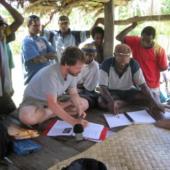Gabriela Pérez Báez was the Curator of Linguistics at the National Museum of Natural History. She focused her work on language documentation and analysis, as well as factors of language maintenance and endangerment.

Highlights
- 7,000+ languages spoken around the world today
- At the current rate of loss, 50% or more of the world’s languages will be no longer spoken or heard by the end of the century without intervention
- 96% of the world's languages are spoken by just 4% of the world's population
- Smithsonian is creating a global network of communities, museums, universities, and other organizations dedicated to recovering our world’s endangered languages
- Through research, public outreach, community collaboration, and Smithsonian collections, Recovering Voices works to preserve language traditions today and for future generations
Locations
- Papua New Guinea
- Mexico
- Canada
Smithsonian’s Recovering Voices initiative promotes the documentation and revitalization of the world’s endangered languages and the knowledge preserved in them. Led by the National Museum of Natural History in partnership with other Smithsonian units—the National Museum of the American Indian and the Center for Folklife and Cultural Heritage—Recovering Voices builds on the international research of Smithsonian curators and connects indigenous communities from around the world with Smithsonian collections in Washington, D.C.
Smithsonian scientists, curators, and archivists support global cultural diversity and preserve endangered languages through work at international sites as well as programming in Washington, D.C. These have included the 2013 Smithsonian Folklife Festival, One World, Many Voices, the ongoing National Breath of Life Archival Institute for Indigenous Languages, and the Community Research Grants (CRG) program.
Recovering Voices organized the 2015 Breath of Life Institute in collaboration with the Myaamia Center at Miami University. This workshop included 29 community researchers who traveled to Washington, D.C., to access archival documentation on 14 native languages and cultures at the National Anthropological Archive, the Library of Congress, and ethnology collections at the National Museum of Natural History and the National Museum of the American Indian. Breath of Life is supported by the Documenting Endangered Languages award, a joint effort between the National Science Foundation and the National Endowment for the Humanities.
A vital part of Recovering Voices is the Community Research Grants (CRG) program. This program enables community scholars specializing in language and traditional knowledge to travel to the Smithsonian to work on collections and archival materials. The collections at NMNH attract communities from across the globe—from neighboring countries like Canada, as well as communities further afield like Samoa.
In 2012, Recovering Voices hosted the Great Lakes Research Alliance for the Study of Aboriginal Arts and Cultures (GRASAC). This group is made up of scholars from universities, museums, and Native communities who use technology to digitally reunite Great Lakes heritage currently scattered across museums and archives in North America and Europe. Their goal is to bring this museological and archival information together with Aboriginal community knowledge, memory, and perspectives. During their visit, elders Myna and Theodore (Ted) Toulouse and Professor Mary Ann Corbiere from Sagamuck and Wikwemikong First Nations reconnected their Anishinaabe language, knowledge of quillwork, maple syrup collecting, and birch bark containers with the NMNH collections. Once back home, inspired by the traditional tools found in the collections but no longer seen in the community, Ted worked with co-team member Al Corbiere (M'chigeeng First Nation) to produce a video on local natural resources like maple syrup collecting to teach Anishinaabe school children their language. Clips of the discussions in Anishinaabemowin that took place when the visitors connected with the early twentieth century collection in the NMNH storage are also included in the records made for the GRASAC database and will be used in a public website that will make GRASAC research widely accessible.
In 2013, groups visited from the Heiltsuk (Bella Bella) and Nuxalk (Bella Coola) communities of the Northwest Coast of Canada. Like GRASAC, these communities had a shared history that they wanted to re-explore through NMNH collections. Youth leaders Ian Reid and Clyde Tallio met for the first time at NMNH and forged a partnership as a means to support their mutual efforts to revitalize language, art, and traditional knowledge in their communities, culminating in their vision to learn more about a historical village that had been co-habited by the Heiltsuk and the Nuxalk.
In collaboration with communities and partner organizations in the United States and at an international level, Recovering Voices broadens access to Smithsonian collections and supports interdisciplinary research, documentation and revitalization. Smithsonian is creating a global network of communities, museums, universities, and other organizations dedicated to this endeavor.
People
Joshua A. Bell is Curator of Globalization at the National Museum of Natural History. He examines shifting local and global networks between people, artifacts, and the environment.
Gwyneira Isaac is the curator for North American Ethnology at the National Museum of Natural History. Her research focuses on Native systems of knowledge, knowledge diversity and the dynamics of intersecting cultural systems.
Mary S. Linn is Curator of Cultural and Linguistic Revitalization at the Smithsonian Center for Folklife and Cultural Heritage (CFCH). She works with indigenous communities on cultural conservation to sustain and revitalize endangered languages.